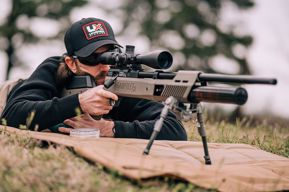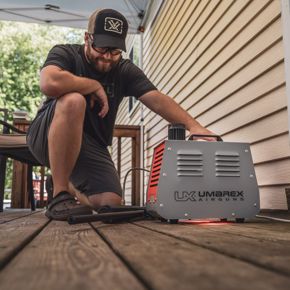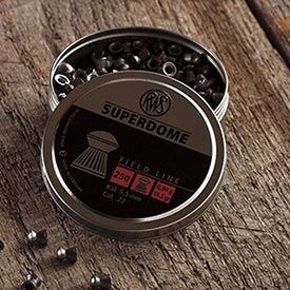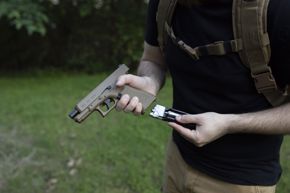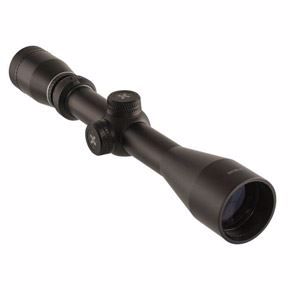Umarex has shaken up the air gun world with the Gauntlet. Pre-charged pneumatic (PCP) air rifles have always worked on a sliding scale that tied price to performance. Devotees paid premiums for reliable performance. Everyone else stood by, jealous. The Gauntlet has upended that standard by providing a reliable rifle with all of the high-end features and performance with a retail price under $300.
The name is a thinly veiled metaphor for what Umarex has just done. They’ve thrown down the gauntlet, as the old idiom says. They’ve undercut the price of the PCP market without sacrificing any of the performance.
Skeptical yet? It would be understandable. Whenever someone says you get all of the performance without the inflated price-tag, skepticism is justified. But I wouldn’t be this deep into the review if Umarex hadn’t lived up to the promise of the hype. The Gauntlet makes PCP air guns accessible, and the performance is spot-on.
Let’s break down the features. The baseline numbers will be guided by caliber. The Gauntlet will be available in .22 and .177. I shot a .177 version and will be using those numbers. Both will offer 10 shot magazines and run from a short-stroke bolt.
The Gauntlet’s consistency is provided by regulated airflow. This holds true for shots all the way to the very end of the charge. Umarex is averaging 1200 FPS for alloy pellets. I was averaging 975 FPS with RWS Super-H-Point 14.2-grain pellets. And the shot variation had a surprisingly narrow range of just +/- 10 FPS. That’s on par with what you’d get from a controlled batch of rimfire rounds.
That consistency results in equally consistent shot placement. Accuracy is solid. The Gauntlet isn’t equipped with iron sights, and it doesn’t come with a scope, so how you decide to top it will be up to you. The Gauntlet has an 11mm rail that makes mounting optics easy. I was using an Umarex 3-9 x 40. As I’m wont to do, I kept it dialed in at 9.
The whole platform is incredibly stable. There’s no recoil at all. I shot it from the bench and standing. Benched is especially rewarding.
The single-stage trigger is adjustable. This one was breaking just over 2 pounds, and the break was clean. Though it isn’t a pistol grip, the grip angle is similar. It is an excellent feel for a rifle that weighs in at 8.5 pounds.
The cheekpiece is adjustable, though the length of the stock isn’t. The balance of a fully gassed Gauntlet is ideal. It has sling mounts that make carrying the gun easy.
The rifle itself is 46.74” long. 28.5” of that is an integrally suppressed barrel. The system is ingenious. The sleeve that covers the barrel is about the diameter of a typical rifle barrel. Inside that protective sleeve is an even thinner rifled barrel. There’s enough air space between the two to quiet this rifle down. It is much more than hearing safe, and the .177 I had (especially on the open range) was as quiet as a suppressed bolt-action rimfire running subsonic rounds. The sound of the pellet striking a steel spinner was louder than the shot itself.
Charging the gun is exceptionally easy. This is often a daunting moment for those new to PCP rifles. How you charge it is up to you. You can do it manually with a pump, or use a compressor or an air tank (like the one I had). The gun has a Foster quick connect fitting that is fool-proof.
The gun’s 13 cubic inch tank (tucked below the barrel) will hold 3,000 psi of pressure. With the .177, that equates to 70 shots. As I mentioned earlier, the regulator controls the consistency.
The Gauntlet can also change out tanks. A pressure release key lets you pull an empty tank if you want to replace it with another that is fully charged. This makes carry a backup tank in the field easy and efficient.
The magazine is the only part of this whole experience that had any sort of learning curve. As with any magazine that holds .177 pellets, you have to load with a bit of caution so you don’t maul the pellets. I mauled a few, for sure. The clear plastic cover rotates away, exposing the hole into which you place a pellet. This also winds the spring that keeps the rotary magazine feeding correctly.
Once loaded up, the magazine slides into the action in front of the bolt. A cut out shows how many more pellets are available and can be seen easily from the right side of the gun. The Gauntlet comes with one magazine, though I’d highly suggest picking up a few, as you won’t want to slow down to load in the field.
For those that want some greater insurance for accurate performance, the magazine can be replaced by a single-shot sled.
When you look at these features and the practical performance, all in one package, the Gauntlet is a stand-out. It helps that it looks good, too. The rifle has some subtle sweeps in the frame that make it more attractive than some PCP guns.
When you consider that the sticker price is going to be under $300, you can see just how daunting the Gauntlet must be to those selling comparable rifles at three times the price.


